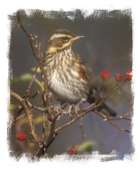

|
|
Nature > Birds > Fieldfare & Redwing |
|
Web links to more information at the foot of the page |
|  |
|
JANUARY - FIELDFARE & REDWING Fieldfares and Redwings are among the visiting birds attracted to the UK each winter by our softer oceanic climate. Both are members of the thrush family. Mostly they migrate at night, arriving from their breeding grounds in Scandinavia and northern Europe during October and November. The arrival of flocks of fieldfares and redwings in our hedgerows is a sure sign that winter is here. In January 2010, as a result of the unusually cold spell, fieldfares and redwing are very common in Barford and can be seen in gardens as well as open ground. Their numbers can build up as winter progresses, particularly if the weather in Scandinavia is severe when more may cross the North Sea. Birds start to return in March, but some may stay until May. FIELDFARES: Fieldfares are very social birds, spending the winter in flocks of anything from a dozen or so to several hundred strong. These straggling, chuckling flocks that roam the countryside are a delightful and attractive part of the winter scene. Recognition:
Fieldfares are similar to a mistle thrush in general size, shape and behaviour. They are around 25cm long with a wingspan of 39 to 42 cm. They stand very upright and move forward with purposeful hops. Where to see?:
Orchards and gardens with apple trees are also favourite places. They will come into town parks and playing fields, especially when there is snow in the surrounding countryside. Many people think of Fieldfares as fruit-eaters but in fact this is not the case, they much prefer grubs and worms, switching to windfall apples and berries when these invertebrates are unavailable. The number of sightings of Fieldfares in domestic gardens during the winter months can vary considerably from one year to the next, depending on the severity of the weather. What does it sound like?: The most often heard sound of the fieldfare
is a harsh, aggressive sounding “chack-chack” call,
as it spots you and moves to a safer distance. REDWINGS: Redwing journey here to over-winter non-stop from southern Scandinavia often in company with fieldfares and blackbirds. Many continue south, to end the winter in Spain and Portugal. Others penetrate no further than south-west England and Ireland before returning north the following March to breed. A few remain through the Summer in Scotland. Recognition:
Where to see: Through the winter the birds remain highly mobile, ebbing and flowing
in parallel with weather conditions.
What does it sound like?: The redwing can be recognised by its thin,
but far-carrying, “seep” notes,
which are much softer and more mellifluous than the Fieldfare’s
call. Illustrations adapted from those by Dave Nurney from - The Pocket Guide to the Birds Of Britain and North-West Europe By Chris Kightley and Steve Madge © Pica Press
|